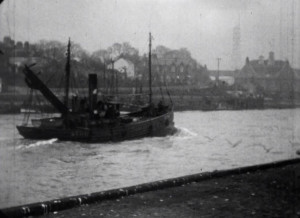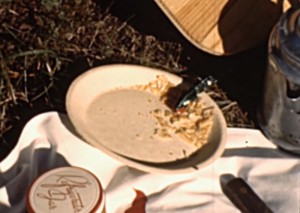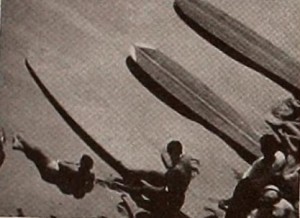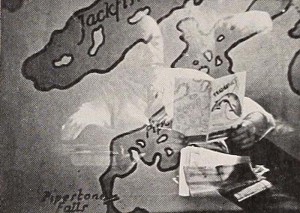
This short film documents the herring fishing industry of Yarmouth.
Travelogue and social gathering document. Narrated by Joan Baldwin with orchestral music by Sibelius throughout. "Only 50 people lived here last winter and 12 children attend the school. Fishing..." oldfilm.org
"A travelogue extolling the virtues of New England as a vacation spot. The film shows people swimming at York Beach; visiting a lighthouse; going deep-sea fishing on the "Pearl" with Captain Brewer and visiting Bald Head Cliff for clams, and Cape Neddick for a close-up look at marine life. The tourists appearing in the film may be the Crawley family. York Beach is located in Maine" Library and Archives Canada.

A group of families takes separate vacations – the husbands go fishing, while the wives and children choose to hold a picnic. Both vacationing groups encounter obstacles that disrupt their plans.

"Dan Billman, jr., has told you in the September number of this magazine how he came to make South of Honolulu. What he could not possibly put into words is the outright and amazing entertainment value of this elaborate record. Hawaii, for the Billmans, meant far more than the Aloha Tower, Diamond Head and the Kodachrome set piece of weekly hula dancing. In their place this adventurous couple found — some 200 miles south of Honolulu — the calm beauty of native life, the exciting patterns of native fishing and feasting and the exotic loveliness of tropical blooms against their true backgrounds. For them, no filming task seemed impossible. Their achievements range from an amusing sequence of the "'sea going" cowboys of the Hawaiian coast, to a striking and incredible study of religious ceremonies within a Buddhist temple. Mr. Billman's beautifully filmed production, accompanied throughout with sound and music personally recorded in the Islands, has the full bodied stature of mature screen entertainment." Movie Makers, Dec. 1941, 564.
"Spear That Fish - Few professionals have yet brought to theatre screens such scenes as Leon Paddock has captured in this entertaining 16mm color film. Using underwater camera equipment which he designed himself, he and an associate journeyed to the west coast of Mexico where they took the camera underwater and shot scenes of sturdy swimmers with water-goggles and swim-fins exploring the marine life of Mexico's off-shore waters. Shown are divers using spears and spear-guns in hunting game fish, and one diver's encounter with devilfish and other unusual marine life. The climax is marked by a duel between a diver and a shark, with the diver knifing the shark and bringing it to surface. The color photography is some of the best 16mm underseas camerawork yet to be seen. It demonstrates unusual skill as well as the filmer's knack of obtaining excellent exposures with color film in the admittedly difficult conditions which underwater invariably presents. The narration on tape contributes adequately to the screen presentation enhancing the continuity of the slick editing of this picture." American Cinematographer, May 1952, 223-4.
This film was produced at some time in the 1950s.
"A lover of wild life and good fishing, Russell Jameson has a real fishing picture for those who would like to go into the wilds of British Columbia where the lakes and streams are generously populated with big ones which are willing to make the anglers' acquaintance. Most of the fishing is with barbless hooks for the sport and catch is returned to the stream uninjured. The musical score and sound effects add a great deal to this picture. It will tempt any fisherman with the time and money to indulge in the sport" PSA Journal, Nov. 1958, 48.

"No better example of human interest in a vacation film will be seen for a long time to come than was exhibited in Two Perfect Weeks, made by Walter F. Hinkle. Strangely enough, there was practically no material of actually catching fish, yet the film gives one the impression that the party consisted of all genuine fishermen and that no more dyed in the wool sportsmen could be found than these happy vacationists. Starting with a clever introduction, the film moves rapidly along into camp. Here, a most handsome array of interest packed close shots serves to tell the story of tired business men at play, until the entire audience is ready to sit down and enjoy a meal of freshly cooked fish. The film ends in a novel way. To signalize the return to civilization, each member of the party is seen shaving off the beard that grew during the two weeks at camp. Although each of the group is introduced by means of a different type of activity, the picturization is at no time slow or dull. The secret lay in the fact that there was no "monkey business" in front of the camera, but rather a good collection of intimate views of the persons going about their various tasks. The color titles are well executed." Movie Makers, Dec. 1939, 632-633.
"Tying A Dry Salmon Fly, 300 ft., 16mm., was awarded special mention because of its unusual subject matter and because of the uniformly fine technique with which it is portrayed. Mr. Brock, both a fisherman and a firmer, has brought one hobby to the aid of another as he shows, with a straightforward continuity, the nice art of fly tying. Working almost entirely in extreme closeups, he overcame the serious problem of limited depth of focus by a canny concentration of his light sources on the tiny subject. In this manner, he was able so to stop down the lens as to achieve maximum definition and depth of field." Movie Makers, Dec. 1931, 685.
Total Pages: 7